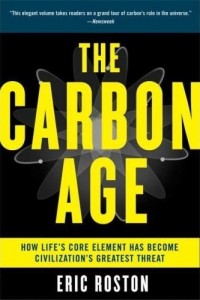This is an excerpt from the book The Carbon Age: How Life’s Core Element Has Become Civilization’s Greatest Threat, newly released in paperback.
 Carbon is all over the news, but what is it?“You will be astonished when I tell you what this curious play of carbon amounts to.”
Carbon is all over the news, but what is it?“You will be astonished when I tell you what this curious play of carbon amounts to.”
— Michael Faraday
Welcome to the Carbon Age.
These days we hear the word “carbon” in the headlines frequently, but we rarely understand much about what it is. Carbon is a culprit in creating one crisis after the next. Carbon dioxide emissions warm the climate. The volatile Middle East explodes atop its stores of volatile hydrocarbons, otherwise known as oil. Carbohydrates’ popularity waxes and wanes with diet crazes. Pharmaceuticals, which often rely on oil-based feedstock, command ever-higher prices. The U.S. military demands carbon fiber for body armor and vehicle protection, which bids up the price for aerospace and sporting goods manufacturers who rely on the same material for everything from airplane wings to tennis rackets. Little remarked upon is the connective tissue that unites these subplots into a bigger story, the dynamic epic of how this element flows through life and industry, entwining evolution with the Earth’s inanimate forces, air, sea, rock and human infrastructure.
We are warned by many books and articles written every year that the carbon cycle, this global flow of carbon, is broken. These crises, sometimes involving life-or-death issues, require continuous public monitoring. Less frequently remarked upon is how the cycle is supposed to work. The Carbon Age teases out the wonder of our world of carbon — and the roles evolution and now industrial civilization have played — through times of havoc and times of stability, in the continuously shifting landscape of carbon. Simply stated, the fastest way to learn the most about the world is through the carbon atom.
A reasonable expectation might hold that the 92 natural elements mix and match equally to create the infinity of life and the planet life grew up on. Not so. The Universe is reasonable — but not that reasonable. Carbon is the fourth most abundant element in the Universe, but not on Earth. This planet is largely a sphere of oxygen and silicon. Carbon is not even counted among the top ten most abundant elements on Earth. Yet it structures and fuels all of life. Carbon is the citizen king of the elements, performing roles in nature from the menial to the extraordinary, and in so doing governs who we are and what life is. “Carbon’s kingliness as an element stems from its mediocrity: it does most things, and it does nothing to extremes, yet by virtue of that moderation it dominates nature,” writes Peter Atkins.
Carbon is the ubiquitous architect, builder, and most basic building material of life. It’s the molecular scaffold of every living creature, and all of the dead ones, too. Carbon is life’s quartermaster, delivering stored energy to cells. Every living thing stores its genetic information in the same language, a chemical alphabet written in a carbon script. By mass, carbon is the largest component in the exquisite spiraling staircase of DNA. Some two dozen elements make up all living things, yet 96 percent of the body is comprised of only four elements — carbon, oxygen, hydrogen, and nitrogen — and most of the oxygen and hydrogen is water. Carbon is the Velcro that holds, frees, and remakes the molecules of life. The oil in our hair and the fat in our gut, skin, and other tissues are essentially hydrocarbons, or carbon frames plugged with hydrogen. Sugars contain carbon, hydrogen, and oxygen, and include everything from sucrose, which gives a cookie its sweetness, to deoxyribose, which girds the parallel helices of DNA. Amino acids are built around single carbon atoms and contain all four of life’s most abundant elements, at least. They are the building blocks of proteins, “nature’s robots,” which structure cells and perform their work.
 Carbon is more than life’s master builder. Civilization is built on a carbon foundation, one much wider than just the global combustion of fossil fuels. Living things and inanimate objects are more similar than they appear. For example, plastic is not just what soda bottles are made of. Plastics are polymers, chains of repeating units, whether they are found on tortoise shells or tortoiseshell sunglass frames, in chickens or rubber chickens. Chemists point out that nylon is a polyamide, like proteins, but it is composed of a single, repeated synthetic amino acid. “We are, all of us, warehouses of natural plastics,” a specialist in plastics failure once wrote, driven by his wife’s cancer to see the tragic similarities between chemical degradation and illness.
Carbon is more than life’s master builder. Civilization is built on a carbon foundation, one much wider than just the global combustion of fossil fuels. Living things and inanimate objects are more similar than they appear. For example, plastic is not just what soda bottles are made of. Plastics are polymers, chains of repeating units, whether they are found on tortoise shells or tortoiseshell sunglass frames, in chickens or rubber chickens. Chemists point out that nylon is a polyamide, like proteins, but it is composed of a single, repeated synthetic amino acid. “We are, all of us, warehouses of natural plastics,” a specialist in plastics failure once wrote, driven by his wife’s cancer to see the tragic similarities between chemical degradation and illness.
If carbon is so instrumental to life — and has always been — it’s tempting to say that every age, from the foggy beginning, has been one of carbon. Yet only one gets to wear the nametag. The Carboniferous period, which spans from 359 million to 299 million years ago, earned its name from massive burial of coal-forming organic carbon. During that period there was a great accumulation of atmospheric oxygen. Woody trees with leaves thrived during the Carboniferous. Their roots altered earth and accelerated the erosion of rocks, sweeping carbon and minerals to the sea, where marine life absorbed some of them. Some of the carbon eventually settled to the seafloor. As erosion drew terrestrial carbon away, the plants and trees continued to exchange molecular oxygen taken from water in return for airborne carbon dioxide. Tall, scaly trees grew old and fell into bogs, hiding their carbon underground, where it stayed until the coal industry began unearthing it some three hundred years ago — seconds in geological time.
Carbon structures life. Oxygen ignites it. Evolution in the Carboniferous entered a period of experimentation that wrought 175-foot, scaly trees with long, floppy leaves, and dragonflies with 30-inch wingspans, a world we might recognize only as science fiction. Today’s carbon age is the Carboniferous period in reverse — coal-fired power plants burn long-buried carbon back into the atmosphere, recombining carbon and oxygen into CO2. Your car is doing the same thing. Gasoline is refined from petroleum that leached from source rocks much more “recently” than the Carboniferous. Most oil became trapped in its underground vaults within the last 90 million years. Not surprisingly, the rise in carbon dioxide associated with global warming is accompanied by a (nonthreatening) decline in the amount of atmospheric oxygen.
We have recently become carbon conscious, trying to measure our “carbon footprint” as if it were a shoe size. That’s fitting, since we are now trying to manage carbon in a way it has never been managed before — a direct consequence of mismanagement. Our carbon age is marked most visibly by rational human attempts to wrestle the Earth’s geochemical cycle back from the brink, after two centuries of burning hydrocarbon minerals.
All of the research, all of the rhetoric, all of the rancor over global warming boils down to two basic notions.
First, the Earth’s temperature and the carbon content of the atmosphere are correlated on every geological time scale. When the temperature goes up, carbon goes up. When the temperature goes down, carbon goes down. That’s usually the sequence of events — first temperature, then carbon — until industrialization, when scientists know that the reverse is true.
The geological record suggests that life has always helped regulate the carbon content of the atmosphere, even though geophysical forces predominate over large timescales. Humans can lay claim to being the speediest, and if trends continue, the most self-destructive regulators of climate. Carbon flows through the atmosphere — by mass a tiny fraction of the global cycle — which is frequently thought of as the flow of carbon through living things, the atmosphere, oceans, land, and from hydrocarbon minerals. These are not static categories, “stove pipes” cut off from each other. They are natural conveyers that converge, forge new directions, and vary their speed. The atmosphere is a (geologically) short-term way station for carbon atoms passing out of living tissue, the high seas, or terra firma.
Dynamism marks the Earth’s climate cycle, but stasis is everywhere locked into the way we think about, organize, and apply scientific knowledge. The administrative and intellectual categories that we divide our institutions into — congressional committees, high school science curricula, newspaper sections — are dozens or in some cases hundreds of years old, and no longer adequately match how we understand the world to work. Universities are rapidly shifting and redefining disciplinary boundaries, particularly as health and biology adopt tools spun from advances in physics and chemistry. “A number of important questions are only able to be addressed at the nexus of the life sciences with the physical, computational and information sciences,” says Shirley Ann Jackson, president of Rensselaer Polytechnic Institute.
Instead of thinking about the world in old-fashioned, static subject categories, such as “climate,” “geology,” “marine chemistry,” or “biology,” non-scientists might think of the behavior of carbon from the molecular to global scales, as “carbon science.” Instead of keeping track of confusing boundary distinctions among scientific disciplines, just scrub them, and follow the carbon.
Science is a curiosity-led, puzzle-solving enterprise. Physical evidence and critical reasoning bring advances in knowledge and the technologies that underpin our lifestyle. Great and aspiring scientists attack the world through the “scientific method,” a tool for logical thought applicable far beyond the laboratory, even if it’s rarely acknowledged beyond the schoolroom. Scientists organize their findings in a hierarchy of knowledge. Confirmed observations are “facts” — trivial but essential bricks in the larger edifice. Accumulated facts can point to broad patterns within nature. As they begin to make sense together, they might suggest a “hypothesis,” which generates testable predictions about the phenomenon under study. A hypothesis that passes many experimental tests can become a scientific “law,” which reliably predicts how a phenomenon behaves. A law may be elevated to the highest echelon of scientific knowledge — “theory” — when its explanatory power reveals fundamental workings of nature.
The second observation that launches this work is that humans have sped up the geological carbon cycle at least one hundred times faster than usual, transforming the world into one that we eventually might not recognize as our own. Abrupt climate change has occurred in the past, as recently as 12,000 years ago, but scientists see no analogue in the record to suggest what searing changes the future holds, or how abrupt change can be. Man-made global warming is a geological aberration, nearly meteoritic in speed.
Homo sapiens is not the first species to hobble a period of stability. But a look at how the Earth works leads to the conclusion that we are changing it faster than ever before, as never before. Scientists distinguish between short-term and long-term carbon cycles. The short-term cycle lasts hours, years, or millennia, and describes carbon’s path through life, waters, soil, and air. The long-term carbon cycle adds another leg to the path, the Earth’s crust. When material settles to the ground or ocean floor, and stays there, carbon’s travel can halt for millions or tens of millions of years. Carbon can remain underground for 200 million or 300 million years, or longer, until a volcano or undersea vent blows it back to the surface system, mostly as carbon dioxide. As a geological phenomenon, human civilization short-circuits the long-term and short-term carbon cycles.
The Earth, its waters, rock, and atmosphere are a massive carbon-laundering operation. Just as carbon atoms flow through regular, chemical cycles within living cells, so, too, do they flow through the grand geochemical cycles of nature. Geologists estimate, and re-estimate, the Earth’s carbon reservoir at more than 75 million billion metric tons, mostly buried in limestone, dolomite, ossified gunk called kerogen, coal, oil, and natural gas. That’s the estimated amount Earth has and has had since its inception. Matter is conserved on Earth, neither created nor destroyed. It just cycles. The atmosphere carries about 900 Gt (gigatons), or billion tons of carbon. That’s more carbon than resides in terrestrial plants, which store about 600 Gt. Soils absorb three times that amount. For all its disproportionate influence on Earth’s habitability, atmospheric carbon makes perhaps a thousandth of a percent of the Earth’s total store. Recoverable fossil fuels might hold between 5,500 and 11,000 Gt of carbon. Most of the short-term carbon flows with the oceans, which carry about 42,000 Gt — maybe fifty times more than the atmosphere. Most of that lies in intermediate and deep waters. The oceans absorb about half of human fossil fuel emissions, a trend that will not continue forever, and that is already showing sings of slowing down.
Wind and water, bacteria, botanicals, and beasts wind through one another, eternally, in the carbon cycle. Carbon atoms hang in the atmosphere for a century or longer, flanked by oxygen atoms, as carbon dioxide. CO2 molecules ricochet off other air molecules, jostle, vibrate, and flip through the atmosphere. Plants suck in this atomic troika from the air and store it temporarily in leaves. An Apatosaurus comes by and eats the leaves. A Tyrannosaurus leaps out and eats the Apatosaurus. The Tyrannosaurus lives to about twenty-eight, before he expels his last lungful of carbon dioxide. Scavengers and bacteria break his corpse down into more carbon dioxide and nitrogen and the two dozen other elements he unwittingly carried around. Rain washes some of his decayed material to the sea, where his carbon can spend 100,000 years in circulation. Everything has its place in the carbon cycle, until it has another place.
It’s not only Eastern mystics and Western self-help gurus who preach that everything is in some advanced state of becoming something else. Chemically and biologically, it’s true. Life and the atmosphere, oceans, and earth are locked in a billions-year-old dance that will continue until the Earth’s volcanic interior shuts down or the Sun burns out, whichever comes first. Until that happens the flow of energy through the Earth system will drive atoms and molecules into ever-increasing complexity.



